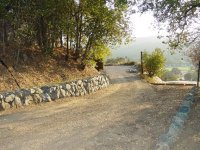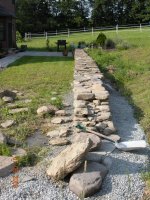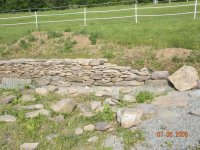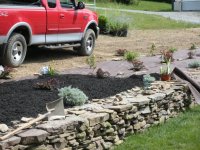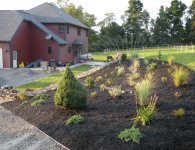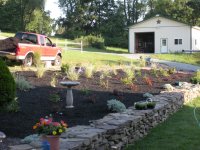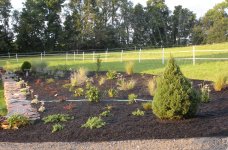You are using an out of date browser. It may not display this or other websites correctly.
You should upgrade or use an alternative browser.
You should upgrade or use an alternative browser.
Boulder wall
- Thread starter Builder
- Start date
/ Boulder wall
#11
dave1949
Super Star Member
Thanks, I appreciate the useful info & pics! :thumbsup:
You are very welcome, hope the job goes well.
Dave.
PA hayseed
Platinum Member
Builder, you do not have to use any type of fabric behind a stone wall. Drystone built retaining walls use "packing" as the material behind the wall, and it is very important on how you lay the packing in. No footers are required, just remove the vegetation and start placing the boulders on the bottom, add a little batter to the wall, and cope the tops. You are supposed to pack as you go, not after the fact. This is how stone masons have been building walls for centuries.
Now, I built a stone retaining wall at my house, and I packed behind some of it, and put 2b gravel in there for drainage. No fabric whatsoever, and since last year no silt, dirt, or debris has flowed out of my wall and the water didn't go into my basement.
Drystone conservancy has some ideas you can use, and they have classes you can go to. I went to one last year and helped rebuild a retaining wall. The only thing I didn't like about the class is that you pay to attend and then bust your butt for two-three days.
Here are some helpful links: Dry Stone Conservancy :: Welcome http://www.tutorials.com/07/0741/0741.asp
Dry Stone Walling Association - Dry Stone Walling Association of Great Britain
good luck! Nothing easy about boulders.
Now, I built a stone retaining wall at my house, and I packed behind some of it, and put 2b gravel in there for drainage. No fabric whatsoever, and since last year no silt, dirt, or debris has flowed out of my wall and the water didn't go into my basement.
Drystone conservancy has some ideas you can use, and they have classes you can go to. I went to one last year and helped rebuild a retaining wall. The only thing I didn't like about the class is that you pay to attend and then bust your butt for two-three days.
Here are some helpful links: Dry Stone Conservancy :: Welcome http://www.tutorials.com/07/0741/0741.asp
Dry Stone Walling Association - Dry Stone Walling Association of Great Britain
good luck! Nothing easy about boulders.
PA hayseed
Platinum Member
Builder, you do not have to use any type of fabric behind a stone wall. Drystone built retaining walls use "packing" as the material behind the wall, and it is very important on how you lay the packing in. No footers are required, just remove the vegetation and start placing the boulders on the bottom, add a little batter to the wall, and cope the tops. You are supposed to pack as you go, not after the fact. This is how stone masons have been building walls for centuries.
Now, I built a stone retaining wall at my house, and I packed behind some of it, and put 2b gravel in there for drainage. No fabric whatsoever, and since last year no silt, dirt, or debris has flowed out of my wall and the water didn't go into my basement.
Drystone conservancy has some ideas you can use, and they have classes you can go to. I went to one last year and helped rebuild a retaining wall. The only thing I didn't like about the class is that you pay to attend and then bust your butt for two-three days.
Here are some helpful links: Dry Stone Conservancy :: Welcome http://www.tutorials.com/07/0741/0741.asp
Dry Stone Walling Association - Dry Stone Walling Association of Great Britain
good luck! Nothing easy about boulders.
Now, I built a stone retaining wall at my house, and I packed behind some of it, and put 2b gravel in there for drainage. No fabric whatsoever, and since last year no silt, dirt, or debris has flowed out of my wall and the water didn't go into my basement.
Drystone conservancy has some ideas you can use, and they have classes you can go to. I went to one last year and helped rebuild a retaining wall. The only thing I didn't like about the class is that you pay to attend and then bust your butt for two-three days.
Here are some helpful links: Dry Stone Conservancy :: Welcome http://www.tutorials.com/07/0741/0741.asp
Dry Stone Walling Association - Dry Stone Walling Association of Great Britain
good luck! Nothing easy about boulders.
BX2230Dude
Silver Member
This is a rock wall I built in 2004 and it's still standing. One of my first projects with the BX2230. 31,000 lbs of rock. I didn't use any fabric. Just stacked the rocks and backfilled with the dirt I cut out of the hillside. It's a little over waist-high on the highest end.
Attachments
MarkV
Super Member
- Joined
- Apr 7, 2000
- Messages
- 5,670
- Location
- Cedartown, Ga and N. Ga mountains
- Tractor
- 1998 Kubota B21, 2005 Kubota L39
This is a rock wall I built in 2004 and it's still standing. One of my first projects with the BX2230. 31,000 lbs of rock. I didn't use any fabric. Just stacked the rocks and backfilled with the dirt I cut out of the hillside. It's a little over waist-high on the highest end.
Doesn't look like it would be a good idea to stay at the Pub to long and mess up on your drive there, BXDude. :shocked::shocked:
MarkV
BX2230Dude
Silver Member
Doesn't look like it would be a good idea to stay at the Pub to long and mess up on your drive there, BXDude. :shocked::shocked:
MarkV
Good point Mark. If you're lucky you'll hit the rock wall, maybe knock out a few rocks and come to a stop. If you're un-lucky you'll go over the shear drop off on the right. The single row of rocks on the right is supposed to prevent that from happening.
Actually this is the beginning of my neighbor's property. The rock wall straddles the property line with about 75% being on my side. I paid about $500 for the rock (almost half of that was delivery). The neighbors offered to pay their share but I told them "forget about it", the additional seat-time was payment enough.
CurlyDave
Elite Member
With rock retaining walls, I have always built and backfilled alternately.
Put down a course of stone, backfill to the height of that course. Set the next course back about half a stone width and after completing that course, backfill again. If you build the stone "wall" first you end up using much more stone, making a stone berm as you describe. No need for that much stone, no need for fabric.
I always turn the stones so the longest dimension is perpendicular to the wall. The wall is thicker and more stable this way.
Put down a course of stone, backfill to the height of that course. Set the next course back about half a stone width and after completing that course, backfill again. If you build the stone "wall" first you end up using much more stone, making a stone berm as you describe. No need for that much stone, no need for fabric.
I always turn the stones so the longest dimension is perpendicular to the wall. The wall is thicker and more stable this way.
rbcsaver
Silver Member
Builder, You leave out a lot of information, such as location, which has a lot of bearing... the wall's purpose, soil type, frost, freeze, heaving, rains, etc. I've built a number of stone walls, which have included some small boulders as well. Water will move "through" a stone/boulder wall, until it turns to ice, which will move the biggest "boulder." Is the wall'
purpose to hold back soil and re-direct water drainage, or just a decorative wall. So many questions and little info. HOWEVER, I always build mine in NE PA with 2B (driveway) stone base for drainage, some 2B stone at the wall base, inside the fabric, the 2B stone behind the fabric 1/2 or slightly more of the wall height, then soil. But we need more info.
http://www.tractorbynet.com/forums/projects/58265-splitting-rock-5.html#post1515165
Plus near done now......
purpose to hold back soil and re-direct water drainage, or just a decorative wall. So many questions and little info. HOWEVER, I always build mine in NE PA with 2B (driveway) stone base for drainage, some 2B stone at the wall base, inside the fabric, the 2B stone behind the fabric 1/2 or slightly more of the wall height, then soil. But we need more info.
http://www.tractorbynet.com/forums/projects/58265-splitting-rock-5.html#post1515165
Plus near done now......
Customer asked me to build a simple, economical, stacked boulder wall to retain ~4' of fill dirt for a large garden. It's about 120' long. As you all know, odd shaped boulders don't stack real well. I trucked in about 15 loads of 24"-48" boulders.
I started out by skimming off a level ledge for the first courses to sit on. I doubled/tripled up on the 2 bottom courses so the next course will stack on top without falling off. Looks more like a boulder "berm" than a wall. Second/3rd course is more challenging.
Would you use fabric behind the wall to keep dirt/mud from coming through the front openings left because the walls are not perfectly sealed? I was also considering a 3" stone vertical layer behind the fabric, then folding the fabric over the top and behind the 3" stone, but cost/complexity is of concern. Can't get too carried away on perfection-it's not supposed to be a work of art, or cost like a work of art. However, don't want smaller rocks being pushed off or mud oozing through.
I'm more used to building stone/mortar or interlocking block wall with proper pipe/drainage behind it. This thing looks like it might be a problem in the future.
Attachments
Those little flat stacked stone walls are a totally different situation. Your's are very decorative. Mine is more functional. This one I'm doing is like a boulder "berm" stacked about 4' high. I took pictures, but need to post them up when I get some more time.
